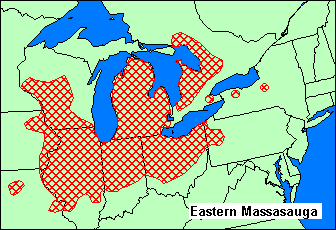Regarding the Massasauga Rattlesnake, I happen to live very near a known den site that has been studied for many years. There is mention of this in the article below. I believe that the Sierra Club in this region has a very good pulse of where they are and the dangers they face being so rare. Here is an article.
Most rural Pennsylvania residents are acquainted with the common snakes that populate our landscape: garter snakes, black rat snakes, black racers, milk snakes and others. And anyone who hikes the woodlands, fields and trails of the state knows to watch for copperheads and timber rattlers, our two common venomous varieties. Much less well known is the Eastern Massasauga rattlesnake, Pennsylvania’s only endangered snake species. This small rattlesnake is classified in Pennsylvania as a “critically imperiled endangered species” and is eligible for federal endangered species listing as well.
They currently populate only Mercer, Butler and Venango counties in western Pennsylvania.
Massasaugas are small, rather stout rattlesnakes with large dark brown or black blotches on the back and sides that stand out against a light gray background. The small rattle sounds like the buzz of an insect and is so soft it can barely be heard from more than five feet away. The young are born alive at about nine inches in length with a “button” on a yellow tipped tail instead of a real rattle. Massasaugas are secretive and docile, rarely striking unless disturbed.
Massasaugas emerge from hibernation in April and live in wet lowland meadows and grasslands, where they feed on small rodents. In late spring and summer, they move to drier upland fields and pastures, where they bask and forage for food. Breeding and birth of young take place in August and September. In fall, winter and early spring they hibernate in crayfish burrows or fissures where they have access to water.
Habitat destruction is the main reason for the alarming decline of this important endangered species. Currently, forest succession, the growth of trees in previously grassy areas, accounts for 75% of their habitat loss. Surface mining and urban development also contribute to habitat destruction. The Massasauga is considered an umbrella species, that is, one whose habitat, if protected, also benefits other species that share similar environment. Deer, turkey, grouse, woodcocks and rabbits can often be found in the grass and underbrush of Massasauga habitat. Because of their sensitivity to environmental degradation, these snakes serve as indicators of environmental quality. They also help to control the
rodent population and rodent-carried disease.
The Western Pennsylvania Conservancy conducts research on Massasauga populations by tagging and tracking individual snakes. And, because Massasauga habitat is often on private land, this organization also offers a program of land management and protection. Technical and financial assistance may be available through various conservation programs and organizations. Interested landowners can contact the Western Pennsylvania Conservancy at waterlandlife.org or the Pennsylvania Fish & Boat Commission at fishandboat.com/habitat.htm for more information.
Gwen Chute
Member Allegheny Group Sierra Club
Endangered Species Action Team
p.s. Some of the snakes I used to come across in Chester County were Copperheads. The water snakes I would come across there were water snakes.


